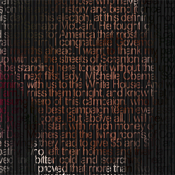work 3
by Patrick Lichty
Click on images to see work
 Michael Takeo Magruder's Reflection (hope and reconciliation) is the culmination of a trilogy of works framing a UK-based US expatriate's observation of the Second Iraq War, from the moments of the WTC impacts in 2001 to the Obama presidential victory speech of 2008. In this piece, a low-resolution Flash video of Barack Obama's speech (with audio), which took place in Chicago's Grant Park, glows on the screen through a mask/stencil of Obama's text. Here, perhaps more explicitly than Jenny Holzer's critical LED pieces dealing with the war that showed at the Chicago MCA in 2008-09, Magruder's screens/walls of text embed and foreground the subtext of the subjects, the people, behind them. Through the screen-sized paragraph, one witnesses the moment of the event's unfolding; the joyous chaos downtown Chicago, the realization of Obama's "Audacity of Hope" maxim, and the metonymic linkage of the new US president with a global discourse of hope, not dissimilar to that of Kennedy during the Cold War.
Michael Takeo Magruder's Reflection (hope and reconciliation) is the culmination of a trilogy of works framing a UK-based US expatriate's observation of the Second Iraq War, from the moments of the WTC impacts in 2001 to the Obama presidential victory speech of 2008. In this piece, a low-resolution Flash video of Barack Obama's speech (with audio), which took place in Chicago's Grant Park, glows on the screen through a mask/stencil of Obama's text. Here, perhaps more explicitly than Jenny Holzer's critical LED pieces dealing with the war that showed at the Chicago MCA in 2008-09, Magruder's screens/walls of text embed and foreground the subtext of the subjects, the people, behind them. Through the screen-sized paragraph, one witnesses the moment of the event's unfolding; the joyous chaos downtown Chicago, the realization of Obama's "Audacity of Hope" maxim, and the metonymic linkage of the new US president with a global discourse of hope, not dissimilar to that of Kennedy during the Cold War.
My problem and challenge in speaking about this work is that I was at the site of Reflection at the time of Obama's speech, and am very likely a pixel somewhere on the screen. Therefore, I hope you will forgive my own lack of distance from the subject, and indulge any personal investment with the honesty of my own self-reflexivity. The experience of the place was singular; the area was saturated with almost every possible ethnicity, hucksters selling t-shirts, buttons, plates, and the general feeling was that this was a unitary moment in US history. What was unfolding was a moment in which the crowd knew that they were there for one reason, no matter what race, creed, or ethnicity, and this was begin reconstruction of the US to a people that could once again respect itself, and be respected by the world.
The importance of Magruder's foregrounding of the human dimension of the moment represented by the work is that, as photographer Subhankar Banerjee said in an April 6th lecture at Columbia College Chicago, contemporary art is handicapped by a cold objectivity that ignores feeling and beauty. This aloofness to these matters ignore the fact that art is, in fact, a site of human connection and intervention, and Magruder exhibits a bicameral/ambihedral mind in showing both the text and the site of occurrence and its atmosphere.
The idea of affect in Magruder's video/text works foregrounds the idea that information, and especially media communication, is not mere data, but data placed within a human context. It is communication. This frame also infers affect, investiture in the subject, engagement, and perhaps even commitment in Adorno's sense, which Magruder's news remixes exhibit. This is not to say that contemporary art should see an emergence of a neo-romantic/neo Post-Raphaelite backlash against the rationalist decentralization of humanity as “bodies” in Postmodern discourse, or the utter irrationality of US “truth-based” neoconservativism. However, it is useful to remember, especially in the Millennial era of coming global crises, humanity cannot be seen as a mass of abstracted bodies or metrics, but people as part of a holistic global system of which they are only one part. This is as simple as the move typified in the shift during the 80's from calling employees “Human Resources” instead of “(Person)nel”.
Magruder suggests that culture may be entering a next phase, one that integrates the rational objectivity of the quantitative data/text, seen here in the form of the implied hopes of a nation and international community. This statement may suggest my personal investment to his subject, but compared to earlier works by Magruder, the human part of information is far more evident. The use of Obama's speech, engraved into a marble wall, or scrolling across a screen, would reverberate as a monument analogous to, but no less appropriate than, the Lincoln Memorial, and the use of the video bring the moment to life. This is why other projects, like Mark Tribe's Port Huron Project also take texts and places them back in a more immediate human context. This is why Magruder's progression from examination from formal data aesthetics to examination of the human hopes and agendas behind the creation of information as anthropomorphized data is so powerful and exciting.

 top top
 back back
|
